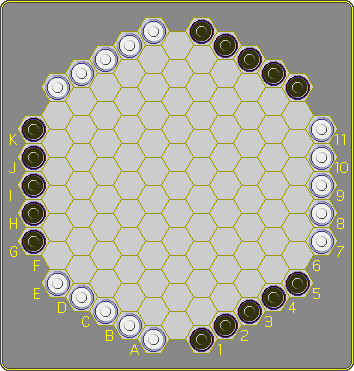The game has a square version, known as Charybdis Square.
There are two players, Black and White. Both have a sufficient number of bi-colured stones, black one side, white the other. The game starts on an empty board. White moves first after which turns alternate.
Rules
 | Definition: a group consists of one stone or two or more like colored connected stones.
|
Capture can only take place in a 'growing move', not by placing a single stone. It follows the custodian method, best known from Othello, but only in the six main directions (i.e. not along diagonals). The act of enclosing a straight unbroken line of the opponent's stones between stones of the moving player, effectuates the capture and immediate reversal of the enclosed stones. The fixed black and white stones along the edge can be used for enclosure as if they were ordinary stones.
- The only restriction on single placement is that the stone may not be placed adjacent to a like colored group. It may be placed adjacent to an opponent's group or groups, but any custodian enclosure it may thus make does not result in a capture.
- Using option one, a player may grow one stone at any or every of his existing groups. If he connects two of them with a single placement, the resulting group may grow no more in that turn. Two groups may be connected by growing both of them, as long as both placements only touch one another, but neither placement is adjacent to both original groups.
If growth results in one or more of the opponent's stones to be enclosed in the custodian fashion described, these are immediately reversed, to unite their captors in one group. Such a group may grow no more in that same turn. However, other groups may still be there that have not yet used their option to grow, and these may still grow and/or capture, using, if possible, the stones that were previously captured, to enclose more stones.
Note that large captures result in large groups, with restricts growing and capturing options in subsequent turns. This negative feedback should be kept in mind.
Object
Not surprisingly we're going for the largest territory here. The board has 61 cells, none of which are safe, and a draw is not possible.
Another object
Of course players may agree that, all things being equal, the player who first connects three sides of his color with a group of his color wins.
Charybdis © MindSports
No applet
